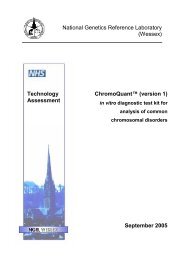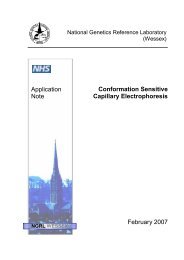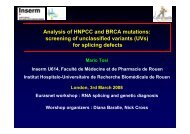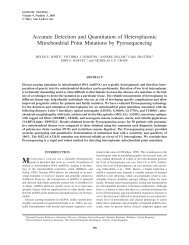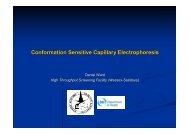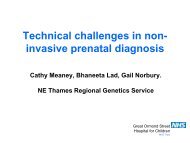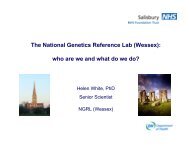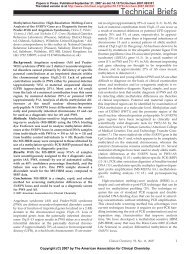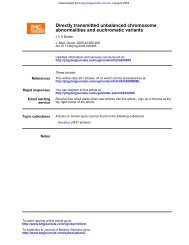Introduction to bioinformatics - National Genetics Reference ...
Introduction to bioinformatics - National Genetics Reference ...
Introduction to bioinformatics - National Genetics Reference ...
You also want an ePaper? Increase the reach of your titles
YUMPU automatically turns print PDFs into web optimized ePapers that Google loves.
Shedding some light on<br />
Bioinformatics<br />
Dr. Georgina Moul<strong>to</strong>n<br />
BioHealth Informatics Education and Development Fellow<br />
(georgina.moul<strong>to</strong>n@manchester.ac.uk)
Outline<br />
• Bioinformatics definition and his<strong>to</strong>ry<br />
• <strong>Introduction</strong> <strong>to</strong> computers<br />
• Challenges of Bioinformatics for Bioinformaticians<br />
• Challenges and issues of Bioinformatics for end-users –<br />
using some examples of <strong>bioinformatics</strong> databases and<br />
<strong>to</strong>ols.<br />
• Ground rules!
What is Bioinformatics?<br />
“Bioinformatics is the field of science in which biology,<br />
computer science, and information technology merge in<strong>to</strong><br />
a single discipline. The ultimate goal of the field is <strong>to</strong><br />
enable the discovery of new biological insights and <strong>to</strong><br />
create a global perspective from which unifying principles<br />
in biology can be discerned.”<br />
http://www.ncbi.nlm.nih.gov/About/primer/<strong>bioinformatics</strong>.html
What is Bioinformatics?<br />
Wet-lab<br />
In-silico<br />
Analysis<br />
Sequence<br />
Structure<br />
Function<br />
Evolution<br />
Pathway<br />
Interaction<br />
Mutation<br />
Expression<br />
Hypothesis
GENE EXPRESSION ANALYSIS<br />
COMPARATIVE GENOMICS<br />
HTGS<br />
DNA sequencing<br />
Genotyping<br />
Taq-Man<br />
TEXT MINING<br />
Genomics<br />
PHENOME<br />
PHYSIOME<br />
Physiomics<br />
Information<br />
Extraction<br />
GENOME<br />
Natural Language Processing<br />
Tiling arrays<br />
SNP chips<br />
Transcrip<strong>to</strong>mics<br />
TRANSCRIPTOME<br />
BIOINFORMATICS<br />
Bioinformaticians<br />
BIBLIOME<br />
Bibliomics<br />
Text Categorisation<br />
Microarrays<br />
PROTEOME<br />
Proteomics<br />
INTERACTOME<br />
Interac<strong>to</strong>mics<br />
2D electrophoresis<br />
MALDI-MS<br />
NMR<br />
METABOLOME<br />
Metabolomics<br />
Metabolic profiling<br />
2-hybrid system<br />
PROTEIN EXPRESSION<br />
ANALYSIS<br />
Protein Chips<br />
Mass<br />
Spectrometry<br />
SYSTEMS BIOLOGY
Bioinformatics Questions<br />
• What genes are in chromosomal region X and are linked<br />
<strong>to</strong> disease?<br />
• What genes cause the condition?<br />
• What is the normal function of gene Y?<br />
• What mutations have been linked <strong>to</strong> diseases A and B?<br />
• How does the mutation M alter gene function F?<br />
• What is the 3D structure of gene Y?<br />
• Is gene Y expressed in condition C?<br />
• Are there any known variants of gene G?
Growth of Sequences and Annotations<br />
(since 1982)
Challenges in Bioinformatics<br />
• Data s<strong>to</strong>rage<br />
– What is the most efficient way of s<strong>to</strong>ring it?<br />
• Data interoperability<br />
– How can we get <strong>bioinformatics</strong> resources be linked?<br />
• Data analysis<br />
– Au<strong>to</strong>mated pipelines? Reliability?<br />
– How can we analyse all data from High Throughput Sequencing<br />
efforts?<br />
Impact on how you (as end users )<br />
extract, use, analyse and visualise<br />
<strong>bioinformatics</strong> data
Computers – they are your<br />
workbench
Computers – they are everywhere!<br />
• A Computer is a machine that manipulates data according<br />
<strong>to</strong> a list of instructions<br />
• A Personal Computer (PC) is any general purpose<br />
computer that is used by individuals<br />
Purchase request<br />
Tune download<br />
iTunes interface<br />
iTunes database
Computer Software<br />
On a computer there is:<br />
1. Operating System<br />
– Manages the resources and provides an interface for programs<br />
– Windows, MS-DOS, Unix, Linux<br />
2. Programs<br />
– A set of instructions for the computer [wikipedia, 2009]<br />
– Executable<br />
– Manipulate data<br />
• Bioinformatics software (<strong>to</strong>ols) is developed by software<br />
developers using an iterative process with users
Biological Databases<br />
Purpose<br />
1. To disseminate biological data and information<br />
2. To provide biological data in computer-readable form<br />
3. To allow analysis of biological data<br />
A database needs <strong>to</strong> have at minimum a specific <strong>to</strong>ol for<br />
searching and data extraction.<br />
– Web pages, books, journal articles, tables, text files, and<br />
spreadsheet files cannot be considered as databases
Major Bioinformatics Databases<br />
• Growing steadily in number and in size<br />
– In Nucleic Acids Research journal, they reported 179 databases, 95 were new<br />
– In <strong>to</strong>tal there are 1170 molecular biology databases<br />
• Specialisations<br />
– Which genome they contain (mouse, human, all of them)<br />
– Which types of information about the genome they contain<br />
• Contain information such as<br />
– Sequences: of bases and of residues<br />
– Structure: 3d conformations of known proteins<br />
– Families: Which sets of genes are known <strong>to</strong> be homologous<br />
– Annotations: which processes each gene is involved in<br />
• And lots of other information<br />
– Conceptual structure<br />
• How concepts in biology/genetics are related <strong>to</strong> each other<br />
• Here is a list of some of the different ones
Primary sequence resources<br />
Nucleic<br />
EMBL<br />
GenBank<br />
DDBJ<br />
Protein<br />
SWISSPROT<br />
TrEMBL<br />
PIR<br />
NRL-3D<br />
•They have long-term national or international funding<br />
•The resources are:<br />
– Archival: they take the data as produced with little or no addition of<br />
information<br />
– Horizontal: they gather all of a type of information from all sources
Nucleic Acid Sequence Databases<br />
• General purpose databases focusing on DNA sequences<br />
and their properties<br />
• Three types of database:<br />
– Genbank (hosted at NCBI)<br />
– EMBL (hosted at EBI)<br />
– DDBJ (hosted in Japan)<br />
• GenBank, EMBL and DDBJ exchange data <strong>to</strong> ensure<br />
comprehensive worldwide coverage and accession<br />
numbers are managed consistently between the three<br />
centers.
Important identifiers for database entries<br />
LOCUS NM_000492 6132 bp mRNA linear PRI 07-OCT-2007<br />
DEFINITION Homo sapiens cystic fibrosis transmembrane conductance regula<strong>to</strong>r<br />
(ATP-binding cassette sub-family C, member 7) (CFTR), mRNA.<br />
ACCESSION NM_000492<br />
VERSION NM_000492.3 GI:90421312<br />
KEYWORDS .<br />
SOURCE Homo sapiens (human)<br />
ORGANISM Homo sapiens<br />
Eukaryota; Metazoa; Chordata; Craniata; Vertebrata; Euteleos<strong>to</strong>mi;<br />
Mammalia; Eutheria; Euarchon<strong>to</strong>glires; Primates; Haplorrhini;<br />
Catarrhini; Hominidae; Homo.<br />
REFERENCE 1 (bases 1 <strong>to</strong> 6132)<br />
AUTHORS Pall,H., Zielenski,J., Jonas,M.M., DaSilva,D.A., Potvin,K.M.,<br />
Yuan,X.., Huang,Q. and Freedman,S.D.<br />
Modification date of entry<br />
TITLE Primary sclerosing cholangitis in childhood is associated with<br />
abnormalities Accession in cystic numbers fibrosis-mediated identify the chloride database channel entry function<br />
JOURNAL J. Pediatr. 151 (3), 255-259 (2007)<br />
PUBMED 17719933 Accession number is a unique identifier<br />
REMARK GeneRIF: There is a high prevalence of CFTR-mediated ion transport<br />
dysfunction Sequence in subjects Identifiers/GI with childhood numbers primary usually sclerosing are NOT unique.<br />
cholangitis.<br />
.........
Issue 1: Why so many IDs? Biology!<br />
Gene Symbol (CFTR)<br />
GeneID – Unique <strong>to</strong> organism (1080)<br />
Transcript ID -1<br />
•Transcript 1 version1<br />
•Transcript 1 version2<br />
•Transcript 1 version3<br />
Transcript ID -2 etc<br />
•Transcript 2 version1<br />
•Transcript 2 version2<br />
When publishing always refer <strong>to</strong> sequence<br />
accession number (unique), version and date<br />
of database, and the gene symbol.
Issue 2: Data Quality<br />
• Is the sequence and associated data up-<strong>to</strong>-date?<br />
• Genbank/EMBL allow direct submissions of nucleotide<br />
sequences by the scientist who actually conducted the<br />
sequencing<br />
• It is the responsibility of the author <strong>to</strong> keep the database<br />
entry up-<strong>to</strong>-date – sequence may change, features found<br />
etc.<br />
• There is no or little data quality check carried out by the<br />
hosting institutions.
Issue 3: Data redundancy<br />
COMMENT REVIEWED REFSEQ: This record has been curated by NCBI staff. The<br />
reference sequence was derived from M28668.1, AC000111.1 and<br />
AC000061.1.<br />
On Mar 24, 2006 this sequence version replaced gi:6995995.<br />
Summary: This gene encodes a member of the ATP-binding cassette<br />
(ABC) transporter superfamily. ABC proteins transport various<br />
molecules…..[removed]. [provided by RefSeq].<br />
COMPLETENESS: full length.<br />
PRIMARY REFSEQ_SPAN PRIMARY_IDENTIFIER PRIMARY_SPAN COMP<br />
1-1539 M28668.1 1-1539<br />
1540-1558 AC000111.1 99186-99204<br />
1559-1972 M28668.1 1559-1972<br />
Data Redundancy<br />
1973-1990 AC000111.1 131715-131732<br />
It is often that there are more than one database entry<br />
that corresponds <strong>to</strong> the same gene or entity<br />
1991-2628 M28668.1 1991-2628<br />
2629-2650 AC000111.1 134643-134664<br />
In some cases these get merged – like here<br />
2651-5731 M28668.1 2651-5731<br />
5732-6132 AC000061.1 58618-59018
5732-6132 AC000061.1 58618-59018<br />
FEATURES Location/Qualifiers<br />
source 1..6132<br />
/organism="Homo sapiens"<br />
/mol_type="mRNA"<br />
/db_xref="taxon:9606"<br />
/chromosome="7"<br />
/map="7q31.2"<br />
gene 1..6132<br />
/gene="CFTR"<br />
/gene_synonym="ABC35; ABCC7; CF; CFTR/MRP; dJ760C5.1;<br />
MRP7; TNR-CFTR"<br />
/note="cystic fibrosis transmembrane conductance regula<strong>to</strong>r<br />
(ATP-binding cassette sub-family C, member 7)"<br />
/db_xref="GeneID:1080"<br />
/db_xref="HGNC:1884"<br />
/db_xref="HPRD:03883"<br />
/db_xref="MIM:602421"<br />
Gene names – very useful for humans! Not unique – look at the number<br />
of synonyms!
CDS 133..4575<br />
Database entries usually cross-reference <strong>to</strong> other databases<br />
/gene="CFTR"<br />
Navigation: you can click on them and go <strong>to</strong> those entries!<br />
/gene_synonym="ABC35; ABCC7; CF; CFTR/MRP; dJ760C5.1;<br />
MRP7; TNR-CFTR"<br />
Remember /note="ATP-binding this is a gene entry: cassette if there sub-family is a translation, C, member you can 7"<br />
navigate <strong>to</strong> the corresponding protein entry.<br />
/codon_start=1<br />
/product="cystic fibrosis transmembrane conductance<br />
regula<strong>to</strong>r"<br />
/protein_id="NP_000483.3"<br />
/db_xref="GI:90421313"<br />
/db_xref="CCDS:CCDS5773.1"<br />
/db_xref="GeneID:1080"<br />
/db_xref="HGNC:1884"<br />
/db_xref="HPRD:03883"<br />
/db_xref="MIM:602421"<br />
/translation="MQRSPLEKASVVSKLFFSWTRPILRKGYRQRLELSDIYQIPSVD<br />
SADNLSEKLEREWDRELASKKNPKLINALRRCFFWRFMFYGIFLYLGEVTKAVQPLLL<br />
GRIIASYDPDNKEERSIAIYLGIGLCLLFIVRTLLLHPAIFGLHHIGMQMRIAMFSLI
A protein entry!<br />
LOCUS NP_000483 1480 aa<br />
linear PRI 15-MAR-2009<br />
DEFINITION cystic fibrosis transmembrane conductance regula<strong>to</strong>r [Homo sapiens].<br />
ACCESSION NP_000483<br />
VERSION NP_000483.3 GI:90421313<br />
DBSOURCE REFSEQ: accession NM_000492.3<br />
KEYWORDS .<br />
SOURCE Homo sapiens (human)<br />
ORGANISM Homo sapiens<br />
Eukaryota; Metazoa; Chordata; Craniata; Vertebrata; Euteleos<strong>to</strong>mi;<br />
Mammalia; Eutheria; Euarchon<strong>to</strong>glires; Primates; Haplorrhini;<br />
Catarrhini; Hominidae; Homo.<br />
REFERENCE 1 (residues 1 <strong>to</strong> 1480)<br />
AUTHORS San<strong>to</strong>s,R.P., Prestidge,C.B., Brown,M.E., Urbancyzk,B.,<br />
Murphey,D.K., Salva<strong>to</strong>re,C.M., Jafri,H.S., McCracken,G.H. Jr.,
FEATURES Location/Qualifiers<br />
source 1..1480<br />
/organism="Homo sapiens"<br />
/db_xref="taxon:9606"<br />
/chromosome="7"<br />
/map="7q31.2"<br />
Protein 1..1480<br />
/product="cystic fibrosis transmembrane conductance<br />
regula<strong>to</strong>r"<br />
/note="ATP-binding cassette sub-family C, member 7"<br />
/calculated_mol_wt=168011<br />
Region 78..641<br />
/region_name="MdlB"<br />
/note="ABC-type multidrug transport system, ATPase and<br />
permease components [Defense mechanisms]; COG1132"<br />
/db_xref="CDD:31327"<br />
Region 84..350<br />
/region_name="ABC_membrane"<br />
/note="ABC transporter transmembrane region; cl00549"<br />
/db_xref="CDD:119924"
Issue 4: Navigation of database entries<br />
using database cross-references<br />
references<br />
• It is certainly a lot smoother than what it; however, you<br />
still have <strong>to</strong> be careful<br />
• Problems:<br />
– Database updates are out of synchronisation<br />
– Databases has merged entries, thus using a different accession<br />
number
NCBI Map of links<br />
between Entrez nodes<br />
and types of databases<br />
However, there are links<br />
between databases that<br />
are NOT hosted at the<br />
NCBI
• UniProt is a collaboration between the European Bioinformatics<br />
Institute (EBI), the Swiss Institute of Bioinformatics (SIB), and the<br />
Protein Information Resource (PIR).<br />
– The SIB used <strong>to</strong> put out “Swiss-Prot”, which was a curated database of<br />
protein sequences.<br />
– EBI used <strong>to</strong> put out TrEMBL, an uncurated, au<strong>to</strong>mated database of<br />
nucleotide sequences translated in<strong>to</strong> proteins.<br />
– PIR also had a protein database, PSD, along with a set of curated protein<br />
families.<br />
– They pooled their resources, reducing 3 websites <strong>to</strong> one.<br />
• The main product is UniProtKB (Uniprot Knowledge Base, i.e a<br />
database).
An accession number and identifer<br />
Note: this shows many different types of<br />
protein functional/structural and<br />
interaction data
Issue 5: Annotation quality for biological<br />
databases<br />
• Annotation is additional information <strong>to</strong> the raw<br />
sequence; for example, references, gene position,<br />
cross – links <strong>to</strong> other databases<br />
• Most genes/proteins are identified and annotated<br />
based on the similarity <strong>to</strong> other genes with known<br />
functions using au<strong>to</strong>mated <strong>bioinformatics</strong> <strong>to</strong>ols<br />
(pipeline)<br />
• Comparison was made when data was less complete<br />
• If sequence is incorrectly annotated, the error<br />
propagates in the database
Issue 5 cntd.<br />
• Most databases state how the data was generated<br />
– for example, in Ensembl, genes are<br />
au<strong>to</strong>matically predicted and then manually<br />
checked.<br />
• Another example, SWISSPROT is manually<br />
curated, TrEMBL contains au<strong>to</strong>matics translations<br />
from nucleotide databases
Issue 6: Describing the gene (or<br />
anything) in standard terms<br />
• The Gene On<strong>to</strong>logy<br />
– http://www.geneon<strong>to</strong>logy.org/<br />
– Knowledge about gene function (the on<strong>to</strong>logy itself)<br />
• There are other examples:<br />
– The MGED On<strong>to</strong>logy (arising from MIAME)<br />
• http://mged.sourceforge.net/<br />
• Annotation of microarray experiments for public reposi<strong>to</strong>ries<br />
– Clinical Bioinformatics On<strong>to</strong>logy:<br />
• Annotation of gene tests in electronic medical records<br />
• http://www.cerner.com/cbo
Issue 6 cntd: : Standard vocabulary<br />
• Human Phenotype On<strong>to</strong>logy<br />
– standardized vocabulary of phenotypic abnormalities encountered in<br />
human disease<br />
– http://www.human-phenotype-on<strong>to</strong>logy.org/index.php/hpo_home.html<br />
• Uses include:<br />
– clinical diagnostics in human genetics (Phenomizer)<br />
– <strong>bioinformatics</strong> research on the relationships between human<br />
phenotypic abnormalities and cellular and biochemical networks,<br />
– mapping between human and model organism phenotypes<br />
– providing a standardized vocabulary for clinical databases
polyA_site 6132<br />
ORIGIN<br />
/gene="CFTR"<br />
/gene_synonym="ABC35; ABCC7; CF; CFTR/MRP; dJ760C5.1;<br />
MRP7; TNR-CFTR"<br />
The Sequence<br />
1 aattggaagc aaatgacatc acagcaggtc agagaaaaag ggttgagcgg caggcaccca<br />
61 gagtagtagg tctttggcat taggagcttg agcccagacg gccctagcag ggaccccagc<br />
121 gcccgagaga ccatgcagag gtcgcctctg gaaaaggcca gcgttgtctc caaacttttt<br />
181 ttcagctgga ccagaccaat tttgaggaaa ggatacagac agcgcctgga attgtcagac<br />
241 atataccaaa tcccttctgt tgattctgct gacaatctat ctgaaaaatt ggaaagagaa<br />
301 tgggatagag agctggcttc aaagaaaaat cctaaactca ttaatgccct tcggcgatgt<br />
361 tttttctgga gatttatgtt ctatggaatc tttttatatt taggggaagt caccaaagca<br />
421 gtacagcctc tcttactggg aagaatcata gcttcctatg acccggataa caaggaggaa<br />
481 cgctctatcg cgatttatct aggcataggc ttatgccttc tctttattgt gaggacactg
Issue 7: sequence formats – how many?!<br />
• Many different sequence formats<br />
• Different pieces of software use different ones, so check<br />
yours is in the correct format<br />
• They are ASCII Text and use the IUPAC standard one-letter<br />
code.<br />
• Most sequence formats include at least one ID name, placed<br />
usually somewhere <strong>to</strong>wards the <strong>to</strong>p of the sequence format<br />
• You can convert between different formats using the program<br />
seqret<br />
(http://embossgui.sourceforge.net/demo/seqret.html)
Common sequence format<br />
• FASTA is the most common<br />
• >sp|P02700|OPSD_SHEEP Rhodopsin - Ovis aries (Sheep).<br />
MNGTEGPNFYVPFSNKTGVVRSPFEAPQYYLAEPWQFSMLAAYMFLLIVLGFPINFLTLY<br />
VTVQHKKLRTPLNYILLNLAVADLFMVFGGFTTTLYTSLHGYFVFGPTGCNLEGFFATLG<br />
GEIALWSLVVLAIERYVVVCKPMSNFRFGENHAIMGVAFTWVMALACAAPPLVGWSRYIP<br />
QGMQCSCGALYFTLKPEINNESFVIYMFVVHFSIPLIVIFFCYGQLVFTVKEAAAQQQES<br />
ATTQKAEKEVTRMVIIMVIAFLICWLPYAGVAFYIFTHQGSDFGPIFMTIPAFFAKSSSV<br />
YNPVIYIMMNKQFRNCMLTTLCCGKNPLGDDEASTTVSKTETSQVAPA
Multiple FASTA sequences in one file<br />
>SEQUENCE_1<br />
MTEITAAMVKELRESTGAGMMDCKNALSETNGDFDKAVQLLREKGLGKAAKKADRLAAEG<br />
LVSVKVSDDFTIAAMRPSYLSYEDLDMTFVENEYKALVAELEKENEERRRLKDPNKPEHK<br />
IPQFASRKQLSDAILKEAEEKIKEELKAQGKPEKIWDNIIPGKMNSFIADNSQLDSKLTL<br />
MGQFYVMDDKKTVEQVIAEKEKEFGGKIKIVEFICFEVGEGLEKKTEDFAAEVAAQL<br />
>SEQUENCE_2<br />
SATVSEINSETDFVAKNDQFIALTKDTTAHIQSNSLQSVEELHSSTINGVKFEEYLKSQI<br />
ATIGENLVVRRFATLKAGANGVVNGYIHTNGRVGVVIAAACDSAEVASKSRDLLRQICMH
You can often download sequences in FASTA<br />
(and other) formats
Sequence Retrieval System (SRS)<br />
• A network browser for databanks in molecular biology<br />
• SRS arose from the lack of standard formats amongst diverse<br />
databases gathered <strong>to</strong>gether at any one site<br />
• SRS permits rapid searching, allowing users <strong>to</strong> retrieve, link &<br />
access all interconnected resources (e.g., nucleic acid, EST, protein<br />
sequence, protein pattern, protein structure, bibliographic, etc.)<br />
• SRS allows queries <strong>to</strong> be formulated across a range of different db<br />
types via a single interface, without having <strong>to</strong> worry about<br />
underlying data-structures, query languages, etc.
Allows you <strong>to</strong> search across<br />
ALL NCBI databases<br />
Entrez
Issue 8: Keeping up-<strong>to</strong><br />
<strong>to</strong>-date with <strong>to</strong>ols<br />
Bioinformatics Resources:<br />
• http://anil.cchmc.org/BioInfoRes.html<br />
• http://www.expasy.org/links.html<br />
• http://www.hsls.pitt.edu/guides/genetics/obrc<br />
• Introduc<strong>to</strong>ry and Advanced Training Programmes<br />
– NWeHealth/NIBHI at The University of Manchester<br />
– EBI/NCBI and other institutions<br />
– Online Training – EMBER (http://www.ember.man.ac.uk)
Issue 9: Which software/database is<br />
most reliable? Which is the best?<br />
• Database<br />
– look for it in the NAR database or issue<br />
– Has it got long-term funding? Anything at NCBI or EBI is safe.<br />
• Software<br />
– Who hosts it?<br />
– Has it been long-term funded?<br />
– Is it cited many times?<br />
– Does it have a comparison <strong>to</strong> other software of its type?<br />
TRY A HANDFUL OF TOOLS AND MAKE A<br />
COMPARISON OF RESULTS!
Issue 10: Data Security and Clinical<br />
Data<br />
• Tools are available <strong>to</strong> the public and are often not secure<br />
• They are not within the NHS firewall<br />
• An example: Alamut is a client/server application<br />
FIREWALL<br />
Purchase request<br />
Tune download<br />
iTunes interface<br />
iTunes database
Ground Rules in Bioinformatics<br />
Ground Rules in Bioinformatics<br />
• Don't always believe what programs tell you<br />
– they're often misleading & sometimes wrong!<br />
• Don't always believe what databases tell you<br />
– they're often misleading & sometimes wrong!<br />
• Don't always believe what trainers tell you<br />
– they're often misleading & sometimes wrong!<br />
• In short, don't be a naive user<br />
– when computers are applied <strong>to</strong> biology, it is vital <strong>to</strong><br />
understand the difference between mathematical &<br />
biological significance<br />
• If you really need support – ask a <strong>bioinformatics</strong><br />
researcher!
We all are bioinformaticians!<br />
“Bioinformatics has become <strong>to</strong>o central <strong>to</strong> biology <strong>to</strong> be<br />
left <strong>to</strong> specialist bioinformaticians. Biologists are all<br />
bioinformaticians now.”<br />
[Stein, L.D.]



